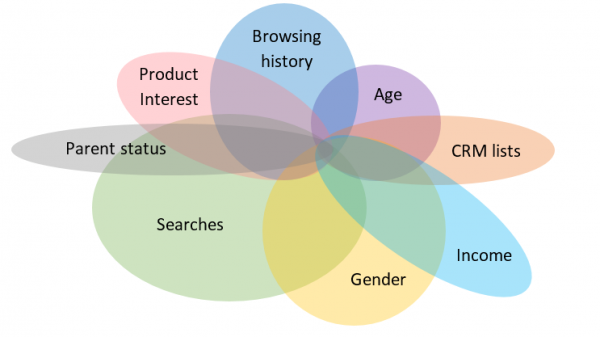Search targeting hasn’t been merely about keyword selection for quite a while. The continued evolution toward persona and intention targeting in recent years gives advertisers a new experience with unprecedented options. These days, search targeting has become more about figuring out who your customers are – where they go, what they research, their likes (and dislikes) and where they are in the buying cycle – and dialing in the crosshairs to those that best fit your defined personas.
In mid-2013, Google’s then-new RLSA feature layered non-search user behavior over keyword searches, giving advertisers a chance to blend remarketing lists with keyword searches. The result? A better-targeted search strategy with stronger conversion rates and performance, but a smaller audience. Combining what had initially only been GDN targets with search was a success for almost all advertisers and opened a new way to issue bid variations based on additional data points.

Fast forward a few years. Search campaigns now have even more targeting layers for zeroing in on select searchers and tightening control on ad reach. Here’s a closer look at some recent audience targeting features and why they matter:
- Customer match – Upload email addresses of customers (or prospects) into AdWords, and target those list members who have Google accounts. Most companies have a gold-mine of CRM data, full of segmented customers, marketing or sales qualified leads, demo viewers, verified decision makers and more. Advertisers can now cut through the clutter and show search ads to their top prospects and customers with greater precision.
- Demographic targeting – Gender and age groups rarely (if ever) perform the same, so why bid the same? Google recently offered demographic details and performance comparisons between age and gender for search campaigns, allowing advertisers to increase or decrease ad exposure to particular groups or combinations that make the most sense to their business.
- Similar audiences – Now available for search campaigns, this feature lets you target new customers who share similar characteristics with those that visit your website. The system looks at search activity around the same time that users were added to your remarketing lists, and creates a list of people that have similar search patterns to your visitors.
- Household Income – Google lets you target income groups “based on publicly available data from the US Internal Revenue Service (IRS).” This feature shows ads to select geographical areas that average a particular household income range. Ideal for those that offer high-end or luxury items and services.
- Parental status – You can target one of three groups called ‘parent,’ ‘non-parent’ and ‘unknown.’ How do they know? According to a Google spokesperson, they “used surveys to find hundreds of thousands of respondents who are self-declared parents with children in their household. Our algorithm takes that data and finds other users across our network that have similar [GDN] and YouTube content consumption patterns and characteristics.” If you sell baby formula, daycare or 529 savings plans, chances are you’ll want to target parents more aggressively, if not exclusively.
- In-market audiences – this wasn’t available for search at the time of publication but was announced by Google to be rolling out to search campaigns soon. This feature gathers a list of high-potential users that are recently and actively searching for, reading about and considering products similar to what you offer. Although somewhat vague in Google’s descriptions, most understand that the factors that likely help Google guess who else is “in your market” include:
- recent website content read
- recent searches performed
- ads selected
Whether expanding your reach or narrowing your scope is the goal, pinpointing ideal customers with greater precision is easier now than ever before. That’s not to say that stacking multiple targeting layers like pancakes is beneficial or desired, though. Those who experiment with complex layering targets soon realize that you can choke your traffic down to a drip if they’re not careful. As with all things search, testing and experimenting into your ideal sweet spot of volume and efficiency is the key.
Search targeting has evolved. Has your targeting strategy evolved to embrace these features? Advertisers stuck in the keyword selection mindset exclusively run the risk of becoming outdated in their expertise and will miss out on smart ways to target additional and better customers.
Need help finding opportunities for growth and figuring out an ideal game plan for optimizing your search targets? Contact our team of SEM Experts now for a complimentary analysis on your paid search targeting!
